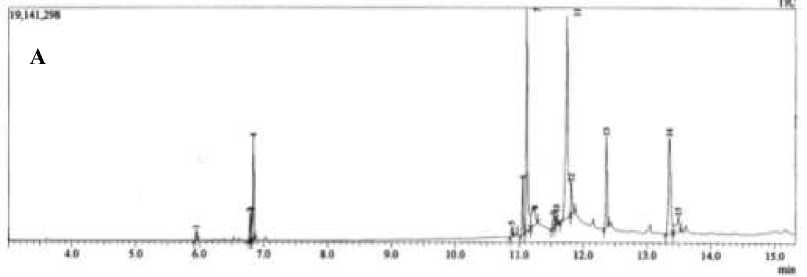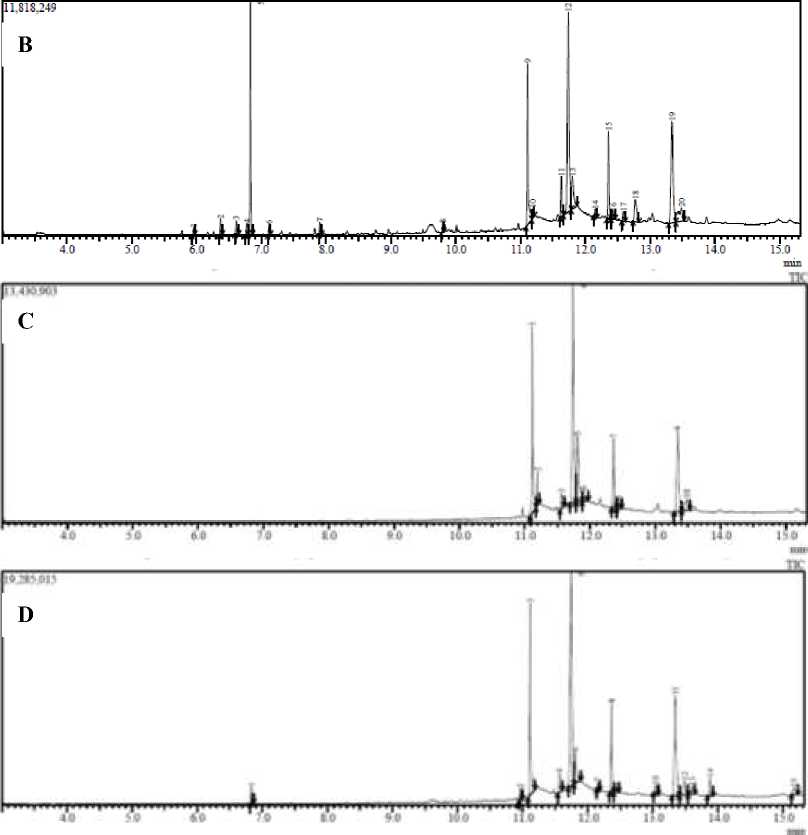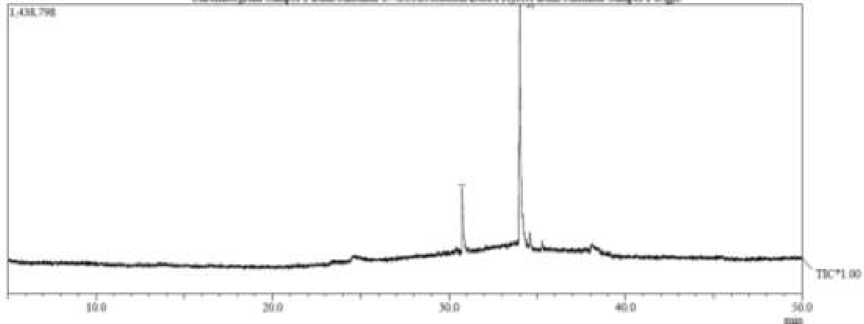PHYTOCHEMICAL SCREENING AND CHEMICAL COMPOTITION OF EUCALYPTUS LEAVES (Melaleuca leucadendron Linn) BY GC-MS
on
Cakra Kimia (Indonesian E-Journal of Applied Chemistry)
Volume 10 Nomor 1, Mei 2022
PHYTOCHEMICAL SCREENING AND CHEMICAL COMPOTITION OF EUCALYPTUS LEAVES (Melaleuca leucadendron Linn) BY GC-MS
Diah Miftahul Aini1 and Surya Hadi2
-
1 Department of Pharmacy, STIKES Kusuma Bangsa, Mataram - Indonesia
-
2 Department of Chemistry, Faculty of Mathematics and Natural Science, Universitas Mataram, Mataram-Indonesia
ABSTRAK: Saat ini minat terhadap penggunaan tanaman aromatik di berbagai bidang kehidupan berdasarkan sifatnya makin meningkat. Oleh karena itu, pada penelitian ini akan dilakukan uji komposisi kimia daun kayu putih (Melalueca leucadendron Linn.) dari Pulau Lombok dengan menggunakan uji fitokimia dan teknik GC-MS (Gas Chromatography -Mass Spectrometry). Hasil uji fitokimia yang teridentifikasi adalah terpenoid, flavonoid, alkaloid, triterpenoid, tanin, dan saponin. Komposisi kimia dari daun kayu putih (Melalueca leucadendron Linn.) ditentukan oleh GC-MS dari ketiga fraksi yaitu etanol, DCM, dan heksana. Komposisi utama dalam ekstrak etanol adalah asam heksadekanoat (26,69%) dan asam heptadekana-8-karbonat (31,19%), pada DCM yaitu 1,8-cineole (2,31%), asam heksaadekanoik (25.88%), heptadecene-8-carbonic acid (28,75%) Sementara senyawa kimia utama yang ada pada heksana adalah 1,8-cineole (23,31%), 1-phellandren (1,33%), terpineol (1,16%), spathulenol (0,85%), ethanone (3,4-epoxy-2-heksanon) (0.72%), asam heksadekanoat (16,06%), dan heptadecene-8-carbonic acid (19,92%).
Kata kunci: Melaleuca leucadendron Linn; 1,8-Cineole; Fitokimia; GC-MS.
ABSTRACT : Recently, there has been increasing interest in the use of aromatic plants, which are used in the different areas of life based on various of the plant properties. The aim of this study was to investigate the chemical composition of Eucalyptus leaves (Melalueca leucadendron Linn.) from Lombok Island by phytochemical screening and GC-MS (Gas Chromatography - Mass Spectrometry) technique. The identified phytochemical screening of the leaves was terpenoid, flavonoid, alkaloid, triterpenoid, tannin and saponin. The chemical composition of the leaves was determined by GC-MS (Gas Chromatography - Mass Spectrometry) at three fractions, such as ethanol, DCM, and hexane. The major compounds in ethanol extract are hexadecanoic acid (26.69%) and heptadecene-8-carbonic acid (31,19%) while in the DCM are 1,8-cineole (2.31%), hexadecanoic acid (25.88%), heptadecene-8-carbonic acid (28.75%). Meanwhile, the major compounds in the hexane are 1,8-cineole (23.31%), 1-phellandren (1.33%), terpineol (1.16%), spathulenol (0.85%), ethanone (3,4-epoxy-2-heksanon) (0.72%), hexadecanoic acid (16.06%), and heptadecene-8-carbonic acid (19.92%).
Keywords: Melaleuca leucadendron Linn; 1.8-Cineole; Phytochemical; GC-MS.
The aromatic medicinal plant Eucalyptus and its essential oils have been used since long time ago in folk medicine. Chemical composition by GC-MS presented the abundance major compound as of 1.8-cineole. Eucalyptus camaldulensis had the strongest bioactivities despite its major compound was spatulenol [1]. Essential oils from four species of Eucalyptus plantation in northern Thailand namely (E. deglupata, E.urophylla, E. citriodora, and E. camaldulensis) were analyzed using GC-MS and 63 compounds were identified, the highest concentration from those was citronellal. E. citriodora oil showed the strongest antioxidant and antibacterial activity and can be a good candidate for the development of product for antioxidant and antibacterial activity [2].
Historically, various preparation from the bark, leaves, and fruits of Eucalyptus species have been used in folk medicine tranquilizers, sedatives, painkillers and in the treatment of various skin disorder. Melaleuca leucadendron flower extract inhibits UVB-induced oxidative damage of HaCaT, reduces pro-inflammatory cell mediators, ensures protection of DNA-damage, and acts as photoprotective agent [3]. Melaleuca leucadendron leaves showed a series of biological activities of interest, including antimicrobial [4], antitumor, and anti inflamatory properties [5], meanwhile Melaleuca leucadendron flower has application as an adjuvant in sunscreen formulations as a strategy to reduce risk of sunburn and prevent skin diseases associated with UV-induced inflammation and cancer [6]. More than 20 species of Eucalyptus have ever been exploited commercially to produce 1.8-cineol (more than 70 %) by cosmetics industries and pharmaceutical. Eucalyptus has many of secondary metabolites as terpenoid [7]. For a few years, essential oils from eucalyptus have
involved interest as the source of natural product. They have presented for their uses as alternative remedies for the treatment of many infections and food preservative. Herein, we conducted study to determine phytochemical screening and GC-MS (Gas Chromatography - Mass Spectrometry) analysis of Melalueca leucadendron Linn which grows in Lombok since no report found about the chemical composition of the plant planted in this island.
Aquades, distilled Ethanol (Merck), DCM (Merck), HCl (Merck), NaCl (Merck), Mayer reagent (K2HgI4) (Merck), H2SO4 (Merck), Mg(s), Liebermann Bunchard (acetid acid-glacial-sulfuric acid), FeCl3 0,1 % (Merck).
Plant Materials
Fresh leaves of M. leucadendron Linn were collected from garden of University of Mataram, Indonesia. The leaves sample were picked in the morning and dried during three days at room temperature and then blended to obtain a small size. The blended sample was put in a beaker glass and macerated with distilled ethanol which was replaced 3 times and the filtrate (crude extract) stored in an Erlenmeyer for further extraction procedure.
The leaves ethanol extract of M. leucadendron Linn was concentrated by using vacuum rotary evaporator at temperature 40℃ with a rate 90 RPM. The yield were the essential oil and crude extract of ethanol. The ethanol extract was then partitioned with DCM and n-hexane to produce three fractions (ethanol, DCM, and n-hexane). The ethanol extract was used to
|
Table 1. Phytochemical Test of Ethanol Extract | ||||
|
No |
Secondary Metabolites |
Positive |
Negative |
Results |
|
1 |
Terpenoids |
√ |
Brown liquid | |
|
2 |
Steroids Triterpenoids |
and Triterpenoids |
Steroid |
Positive Triterpenoid : brown ring between the two solvents |
|
3 |
Flavonoids |
√ |
Aglikon/glikosida: clear green solution Flavon: turned to orange solution after leaving it overnight | |
|
4 |
Alkaloids |
√ |
There was a white sediment (Meyer Reagent) | |
|
5 |
Tannins |
√ |
A blue dark solution | |
|
6 |
Saponins |
√ |
There was foam that lasts for 30 seconds | |
|
7 |
Antrakuinon/ Antrasena |
√ |
A dark green solution. For a positive result it should be red/orange | |
phytochemical test while the three fractions were used to investigate the chemical compounds by GC-MS technique.
Phytochemical test
Phytochemical test used to screen the secondary metabolites contained in the ethanol extract of M. leucadendron Linn was Harborne procedures [8].
GC-MS analysis of three extract of M.leucadendron Linn
Analysis of three extracts were carried out by Gas Chromatography - Mass Spectrometry (GCMS). GC analysis was performed using a Varian Star 3400 Cx chromatograph fitted with a DB-5MS fused silica capillary column. The column temperature was increase from 60 to 260 ℃ at 5 min -1. The total analysis time was 150 min. For GC-MS analysis, the extract was dissolved in ethanol. A 1 μL sample was injected in the split mode ratio 1:10. Helium was used as carried gas at a flow rate of 1 mLmin-1. The injector temperature was
200℃. The mass spectrometer was operated at an emission current of 10 μA and an electron multiplier voltage between 1400 and 1500 V. The percentage compound of the essential oil and extract were computed by normalization method from the GC peak areas, assuming an identical mass response factor for all compounds.
-
3. RESULTS AND DISCUSSION
Phytochemical Screening and Chemical Composition
Table 1 shows that the content of secondary metabolites identified in the ethanol extract of the eucalyptus leaves are terpenoids, flavonoids, alkaloids, triterpenoids, tannins and saponins group. As comparison, it was found a hydrolysable tannin which is isolated from dried fruits of Melaleuca leucadendron and characterized as 1,2-di-O-galloyl-3-O-digalloyl-4,6-O-(S)-hexahydroxydiphenoyl-β-D-glucose as well as known stilbene glycosides and triterpenes[9]. Secondary metabolites from Eucalyptus camaldulensis were identified
flavonoids, pigments, phenolics, terpenes, starches, steroids, and essential oils [10]. Phytochemical investigation of leaves of Eucalyptus globules Labill extracts showed the presence of alkaloids, phenolic compounds, steroids, cardiac glycosides, and terpenes [11].
Based on GC-MS analysis of the three fractions (n-hexane, DCM, and ethanol) of the eucalyptus leaves, it was identified their chemical composition as tabulated in Table 2. The Figure 1 shows the chromatograms of essential oil of eucalyptus leaves, n-hexane extract, DCM extract, and ethanol extract of the eucalyptus leaves.
The chemical compositions in ethanol fraction were dominated by hexadecanoic acid (26.69%) and heptadecene-8-carbonic acid (31,19%) while in the DCM were 1,8-cineole (2.31%), hexadecanoic acid (25.88%), heptadecene-8-carbonic acid (28.75%). Meanwhile the chemical compounds found in the hexane were 1,8-cineole (23.31%), 1-phellandren (1.33%), terpineol (1.16%), spathulenol (0.85%), ethanone (3,4-epoxy-2-heksanon) (0.72%), Hexadecanoic acid (16.06%), and Heptadecene-8-carbonic acid (19.92%).
Bioactivities of Identified Chemical Constituents
The 1.8-cineole is the most significant compositions of Eucalyptus essential oil [12]. This research showed 1.8 Cineole as of 23.31% in n-hexane phase and 2.31 % in ethanol phase. The current study focused on the inhibitory activity of eucalyptol (1.8 cineole) against Mpro/3CLprofrom SARS-CoV-2 [13]. The 1.8-cineole was found in Eucalyptus alba as the major component (76.5-88.1%). In addition to this compound, others that were found including limonene
(3.8–8.6%), α-terpineol (1.4–2.8%), globulol (1.3–6.3%) and α-pinene (1.5–1.8%) [14].
Eucalyptus intertexta has 19 components which were identified in the oils and 1,8-cineole (67.2–83.1 %) also globulol (1.9–8.9 %) act as main constituents. [15]. Three different species of eucalyptus from various locations in Indonesia were studied particularly, such as E. citriodora, E. urophylla, and E. viminalis. The major components of eucalyptus oil were determined to be 1,8-cineole (18.2%– 45.5%) and citronellal (69.27%–82.81%). The highest composition of 1,8-cineole was obtained from the eucalyptus oil extracted from E. urophyllawhereas the highest composition of citronellal was obtained from eucalyptus oil extracted from E. citriodora [16].
Hexadecanoic acid and Heptadecene-8-carbonic acid was found in all fractions of eucalyptus leaves. Both compounds are fatty acids. In the ethanol extract of eucalyptus leaves, there were several compounds of carboxylic acid groups such as Hexadecanoic acid.26.69%, Heptadecene-8-carbonic acid 31.19%, di- (9-octadecenoyl) -glyserol 9.45 %, Glycerol 1,3-dihexadecanoate 9.95%. fatty acid in eucalyptus uses as antibacterial, antioxidant, and antifungal. The Eucalyptus sp. led to the discovery of the role of hexadecanoic acid in the susceptibility of Eucalyptus grandis and Eucalyptus praetoria to A. psidii [17]. The study of volatile oils from Iraqi eucalyptus micro theca plant reveals existence of sixteen compounds, such as amphene (20.60%), 4-carene (18.53%), 1,8-cineole (11.96%), terpin-4-ol (8.70%) and p-cymene (8.39%) were the highest components in these essential oils.

TlC

Figure 1. GC-MS chromatogram of essential oil (A), n-hexane extract (B), DCM extract (C), and ethanol extract (D).

Figure 2. GC-MS chromatogram of esterification yield from extract
Table 2. Chemical Composition of M. Leucadendron Linn Extracted on n-Hexane, DCM, and Ethanol Solvents.
|
Chemical composition |
Extract of n-hexane |
Extract of DCM |
Extract of ethanol | ||
|
SI |
Peak (%) |
SI |
Peak (%) |
SI Peak (%) | |
|
Ethanone CAS 3,4-epoxy-2-heksanon |
86 |
0,72 |
- |
- |
- - |
|
1-phellandren |
95 |
1,33 |
- |
- |
- - |
|
p-cymene |
97 |
1,08 |
- |
- |
- - |
|
1,8-Cineole |
97 |
23,31 |
97 |
2,31 |
- - |
|
Terpineol |
97 |
1,16 |
- |
- |
- - |
|
Spathulenol |
96 |
0,85 |
- |
- |
- - |
|
Hexadecanoic acid |
95 |
16,06 |
97 |
25,88 |
95 26,69 |
|
Heptadecene-8-carbonic acid |
93 |
19,92 |
93 |
28,75 |
91 31,19 |
While nine compounds were obtained as fixed oils, pentadecanoic acid (36.47%) and cis-vaccenic acid (30.31%) were the major components. Eucalyptus micro theca plant possess antibacterial and antioxidant properties and may suggest it as a good candidate to use for medicinal purposes [18]. Eucalyptus sp. from Tunisia were identified gallic acid, fatty acid glycerides, fatty acid esters, phenolic compounds, sitosterol, catechin and ellagic acid. It has antifungal and anti-termite properties [19].
Based on phytochemical test, the content of secondary metabolites in the ethanol extract of eucalyptus leaves were the terpenoids, flavonoids, alkaloids, triterpenoids, tannins and saponin group. The three extracts of n-hexane, DCM, and ethanol of eucalyptus leaves were identified using GC-MS. The compounds found in ethanol extract of M. leucadendron Linn were hexadecanoic acid and heptadecene-8-carbonic acid while in the DCM were 1.8-cineole, hexadecanoic acid, heptadecene-8-carbonic acid, in the hexane were 1.8-cineole, 1-phellandren, terpineol,
spathulenol, ethanone (3.4-epoxy-2-heksanon). The potential compound for the leaves based on review bioactivities the major chemical components were 1.8-cineole (23.31%). Meanwhile the major compounds found in hexane extract was hexadecanoic acid (26.69%) and in ethanol extract was eptadecene-8-carbonic acid (31.19%).
-
[1] Limam H, Ben Jemaa M, Tammar S, Ksibi N, Khammassi S, Jallouli S, et al. Variation in chemical profile of leaves essential oils from thirteen Tunisian Eucalyptus species and evaluation of their antioxidant and antibacterial properties. Ind Crops Prod. 2020; 158. doi:10.1016/j.indcrop.2020.112964.
-
[2] Chahomchuen T, Insuan O, Insuan W. Chemical profile of leaf essential oils from four Eucalyptus species from Thailand and their biological activities. Microchem J. 2020; 158.
https://doi.org/10.1016/j.microc.2020.105 248
-
[3] Brophy JJ, Craven LA, Doran JC. Melaleucas: their botany, essential oils and uses. ACIAR Monogr. 2013;
156,415.
-
[4] Hashim AN, Swilam NF, Moustafa ES, Bakry SM, Labib RM, Barakat HH, et al. A cytotoxic flavonol glycoside from Melaleuca leucadendra leaves extract with immunostimulant activity. Pharmazie, 2018; 73(1), 61-64.
-
[5] Joen STN. Efektivitas ekstrak daun kayu putih (Melaleuca leucadendron L.) sebagai antibakteri secara in vitro. Majority. 2020; 9(2), 45-48.
-
[6] Bianchini Silva LS, Perasoli FB, Carvalho KV, Vieira KM, Paz Lopes MT, Bianco de Souza GH, et al. Melaleuca leucadendron (L.) L. flower extract exhibits antioxidant and photoprotective activities in human
keratinocytes exposed to ultraviolet B radiation. Free Radic Biol Med. 2020; 159,54-65
-
[7] Palá-Paúl J, Pérez-Alonso MJ, Velasco-Negueruela A, Sanz J. Study of essential oils of Eucalyptus resinifera Smith, E. tereticornis Smith and Corymbia maculata (Hook.) K.D. Hill & L.A.S. Johnson, grown in Cuba. Flavour Fragr J. 2002; 17(1), 1-4.
-
[8] Harborne J. Metode Fitokimia. Penuntun Cara Modern Menganalisis Tumbuhan [Internet]. Penerbit ITB Bandung; 1987. 27 p. Available from: http://library.sith.itb.ac.id/%0Aindex.ph p?menu=library&action=detail&libraryI D=5577.
-
[9] Yoshida T, Maruyama T, Nitta A, Okuda T. An hydrolysable tannin and accompanying polyphenols from Melaleuca leucadendron.
Phytochemistry. 1996; 42(4), 1171
1173.
-
[10] Ghasemian A, Eslami M, Hasanvand F, Bozorgi H, Al-abodi HR. Eucalyptus camaldulensis properties for use in the eradication of infections. Comp Immunol Microbiol Infect Dis. 2019; 65, 234-237. DOI
10.1016/j.cimid.2019.04.007
-
[11] Ishnava KB, Chauhan JB, Barad MB. Anticariogenic and phytochemical evaluation of Eucalyptus globules Labill. Saudi J Biol Sci. 2013; 20(1), 69-74.DOI10.1016/j.sjbs.2012.11.003
-
[12] Chograni H, Riahi L, Dhahri S, Ezzine O, Chakroun H, Messaoud C. Interspecific variability of 1,8-cineole content, phenolics and bioactivity among nine Eucalyptus taxa growing under the sub-humid bioclimate stage. J Complement Integr Med. 2021; 14(4) DOI 10.1515/jcim-2019-0159.
-
[13] SHARMA AD, KAUR I. Molecular docking and pharmacokinetic screening of eucalyptol (1,8 cineole) from
eucalyptus essential oil against SARS-CoV-2. Not Sci Biol. 2020; 536-545. DOI 10.15835/nsb12210711.
-
[14] Tine Y, Diallo A, Diop A, Costa J, Boye CSB, Wélé A, et al. The Essential oil of Eucalyptus alba L. Growing on the Salt Zone of Fatick (Senegal) as a Source of 1,8-Cineole and Their Antibacterial Activity. J Drug Deliv Ther. 2020; 10(1-2), 140-143. DOI
10.22270/jddt.v10i1-s.3918.
-
[15] Sefidkon F, Asareh MH, Abravesh Z, Kandi MNH. Seasonal variation in the essential oil and 1,8-cineole content of four eucalyptus species (E. intertexta, E. platypus, E. leucoxylon and E. camaldulensis). J Essent Oil-Bearing Plants. 2010; 13(5), 528-539.
DOI10.1080/0972060X.2010.10643858
.
-
[16] Achmad HN, Rana HE, Fadilla I, Fajar A, Manurung R, Abduh MY. Determination Of Yield and Chemical Composition of Eucalyptus Oil From
Different Species and Locations in Indonesia. Biol Nat Resour Eng J. 2018; 01(01), 36-49.
-
[17] Dos Santos IB, Lopes M da S, Bini AP, Tschoeke BAP, Verssani BAW, Figueredo EF, et al. The Eucalyptus cuticular Waxes contribute in preformed defense against austropuccinia psidii. Front Plant Sci. 2019; 9. DOI
10.3389/fpls.2018.01978.
-
[18] Ali OT, Mohammed MJ. Isolation, characterization, and biological activity of some fatty acids and volatile oils from iraqi eucalyptus microtheca plant. Int J Pharm Qual Assur. 2020; 11(1), 138-143. DOI 10.25258/ijpqa.11.1.21.
-
[19] Elaieb MT, Ben Ayed S, Dumarçay S, De Freitas Homen De Faria B, Thévenon MF, Gérardin P, et al. Natural durability of four Tunisian Eucalyptus spp. And their respective compositions in extractives.
Holzforschung. 2020; 74(3), 260-274. DOI 10.1515/hf-2019-0090.
60

Discussion and feedback